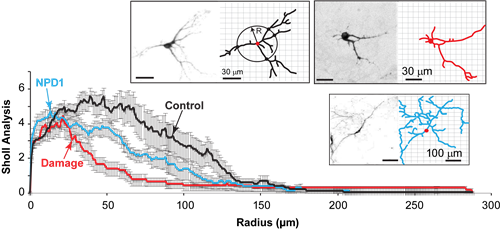
Discovery of neuronal architecture protection by neuroprotection D1 in a novel Parkinson's disease dish model
In a recent report published by our lab, we developed a model of Parkinson's disease in a dish using the primary mesencephalic neurons in culture from mouse. This model has the advantage of focusing on neurons affected by the disease and to be able to chemically damage the neuronal architecture, recapitulating aspects of the disease process. In addition, the model can be used to identify novel disease-modifying molecular mechanisms and to screen potentially useful therapeutic agents. In fact, using this model, we discovered that the lipid mediator neuroprotectin D1 (D1) remarkably protects the neuronal architecture. We took advantage of MPP+ damaged dopaminergic neurons, as well as other toxins. NPD1 rescued cells from apoptosis induced by MPP+ and rotenone, and it counteracted the effects of MPP+ on the dendritic arborization by preventing neurite retraction, an early event occurring in neuronal degeneration. These results suggest that the apoptosis occurring in mesencephalic TH-positive neurons is not a direct consequence of mitochondrial dysfunction alone and that neuroinflammatory-targeted NPD1 signaling may be counteracting this damage. These findings lay the groundwork for the use of the in vitro model for future studies and for the search of specific molecular events that NPD1 targets to prevent early neurodegeneration in Parkinson's disease, especially focusing on the prevention of irreversible loss of dopaminergic neurons.
Calandria JM, Sharp MW, Bazan NG. The Docosanoid Neuroprotectin D1 Induces TH-Positive Neuronal Survival in a Cellular Model of Parkinson's Disease. Cell Mol Neurobiol. 2015;35(8):1127-36. PMCID: PMC4602058. http://www.ncbi.nlm.nih.gov/pmc/articles/PMC4602058/pdf/10571_2015_Article_206.pdf
